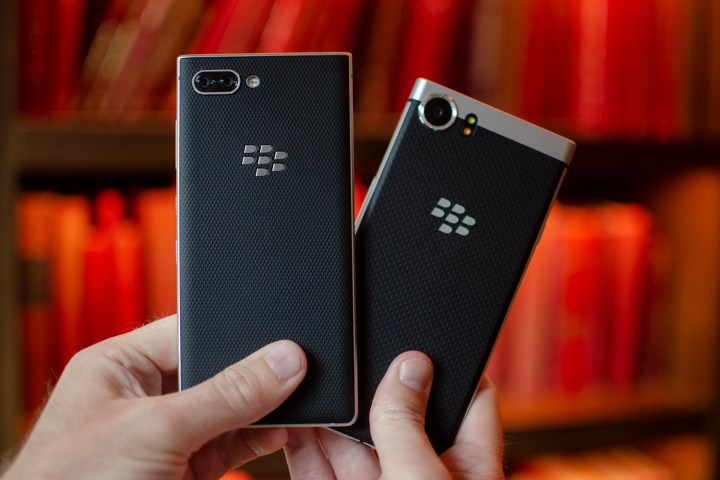
Although it’s a modern Android phone internally, the BlackBerry KeyOne was made to appeal to BlackBerry fans of old. It was aimed more at those who remembered the clickety-clack of a physical keyboard on a phone and wanted to replicate that today than it was for turning the heads of iPhone and Samsung owners. Because of this, it didn’t win over a broad new audience of BlackBerry devotees. The BlackBerry Key2 will change that with a new design and, more crucially, major changes to the keyboard.
If the BlackBerry KeyOne appealed to you but never quite made it into your hand, is the Key2 the one for you? Here are the differences between them, and how the Key2 improves over the KeyOne.
Specs
| BlackBerry Key2 | BlackBerry KeyOne | |
| Size |
151.4 x 71.8 x 8.5 mm (5.96 x 2.82 x 0.33 inches)
|
149.1 x 72.4 x 9.4 mm (5.87 x 2.85 x 0.37 inches) |
| Weight | 168 grams (5.92 ounces) | 180 grams (6.35 ounces) |
| Screen size | 4.5-inch IPS LCD | 4.5-inch IPS LCD |
| Screen resolution | 1,620 x 1,080 pixels (434 pixels per inch) | 1,620 x 1,080 pixels (433 pixels per inch) |
| Operating system | Android 8.1 Oreo | Android 7.1.1 Nougat (will get Oreo soon) |
| Storage space | 64GB (U.S.), 128GB (International) | 32GB |
| MicroSD card slot | Yes | Yes |
| Tap-to-pay services | Google Pay | Google Pay |
| Processor | Qualcomm Snapdragon 660 | Qualcomm Snapdragon 625 |
| RAM | 6GB | 3GB |
| Camera | Dual 12MP, 8MP front | 12MP rear, 8MP front |
| Video | Up to 4K at 30 frames per second (fps) | 2,160p at 30fps |
| Bluetooth version | Bluetooth 5.0 | Bluetooth 4.2 |
| Ports | 3.5mm headphone jack, USB-C | 3.5mm headphone jack, USB-C |
| Fingerprint sensor | Yes | Yes |
| Water resistance | No | No |
| Battery | 3,500mAh | 3,505mAh |
| App marketplace | Google Play Store | Google Play Store |
| Network support | AT&T and T-Mobile | Verizon, AT&T, and T-Mobile |
| Colors | Black, silver | Black, bronze, silver |
| Price | $650 | $400 |
| Buy from | BlackBerry, Amazon, Best Buy | Amazon |
| Review score | Hands-on review | 3.5 out of 5 stars |
Performance, battery life, and charging

BlackBerry hasn’t packed the Key2with the fastest Snapdragon processor but has updated the slightly wheezy Snapdragon 625 in the KeyOne with the much more recent Snapdragon 660. It has also doubled the RAM to 6GB, and the phone comes with 64GB of storage space. A 128GB version will receive a limited international launch.
The battery inside stays almost exactly the same with a 3,500mAh capacity, and there’s still Qualcomm’s Quick Charge 3.0 technology, which is facilitated by a USB Type-C connector. Qualcomm’s Quick Charge 3.0 returns 50 percent charge in a little less than 40 minutes, and BlackBerry expects two days use out of the phone before the battery is flat. This is consistent with the KeyOne. The screen measures 4.5-inches and has a 1,620 x 1,080 resolution. Like the KeyOne, it has a 3.5mm headphone jack and a fingerprint sensor in the keyboard’s space bar.
The Key2 is more powerful and has more RAM and storage. Battery life is about the same as the KeyOne, which means the new phone takes the win.
Winner: BlackBerry Key2
Design and durability
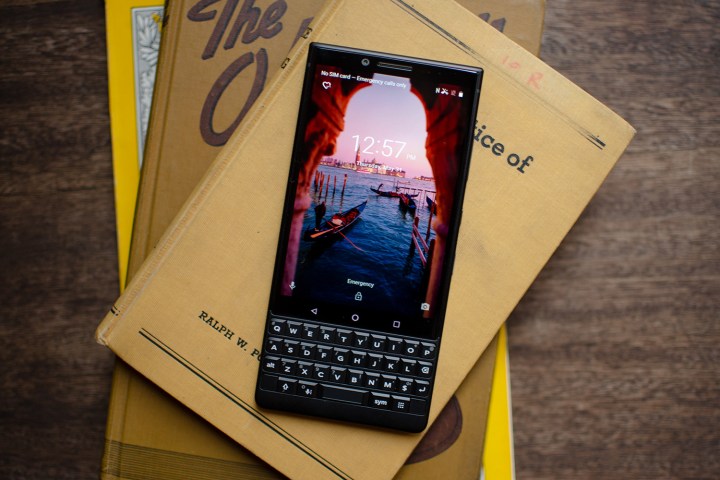
Changes to the Key2’s keyboard, which we’ll go into later, have drastically improved the typing experience over the KeyOne. Those changes are assisted by alterations to the phone’s design. Perhaps the most obvious is when you pick the phone up, which immediately highlights the 12-gram reduction in weight. BlackBerry achieved this by using 7,000 series aluminum for the phone’s body. It’s better balanced too, so it doesn’t “hang” from your fingers quite so much as the KeyOne does, a point further emphasized by the keyboard moving higher up the phone’s body.
The back of the device is more traditional-looking, with its twin camera lenses and central BlackBerry logo. It’s more reminiscent of the BlackBerry Motion’s restrained character than the more heavily styled KeyOne. This is also evident when you examine the phone from the sides and front. The KeyOne’s curvy sides are now flat on the Key2, and a little less comfortable to hold because of it, but the look is considerably more modern. Another very welcome change is that the sleep/wake key has been moved in line with the volume keys and the Convenience Key on the right-hand side of the phone, and it’s textured.
For what the Key2 loses in character — the KeyOne is a striking, distinctly recognizable phone — it makes up in usability and modernity, and it’s a trade-off that arguably had to be made if BlackBerry wants more people than just the die-hard fans queuing up to buy one of its phones. The keyboard prevent BlackBerry from adding water-resistance to the phone, without ruining the feel, so you won’t want to drop the phone in any water.
Winner: BlackBerry Key2
Display
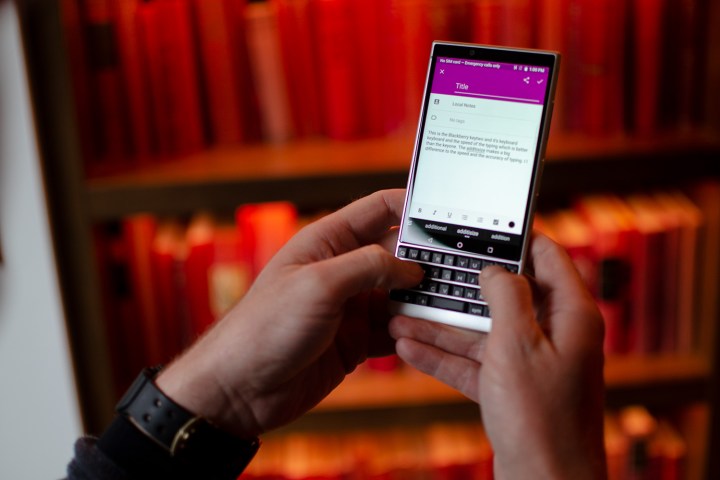
The IPS LCD screen now takes up more space on the front of the phone, even though the 4.5-inch size is unchanged from the KeyOne, as the bezels around it have been shrunk. This reduction has helped BlackBerry make the keyboard on the Key2 larger, and visually makes the phone more attractive and up-to-date. However, because the screen size and the resolution are the same, you won’t notice any difference viewing content on the Key2 over the KeyOne.
Winner: Tie
Camera
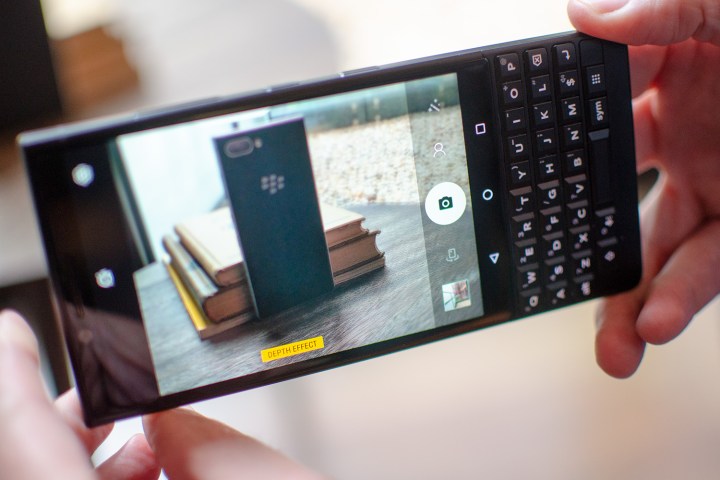
The KeyOne had a surprisingly good camera, a feature rarely associated with BlackBerry phones up till that point. For the Key2, BlackBerry has adopted the latest trend — a dual-lens camera with a portrait mode. The KeyOne’s single f/2.0 aperture, 12-megapixel camera has transformed into a dual 12-megapixel camera setup, with the main camera having an f/1.8 aperture and the secondary an f/2.6 aperture.
While the KeyOne’s camera took decent standard photos, it wasn’t feature-packed. The Key2 has a portrait mode that blurs out the background and isolates the focal subject in the picture. It’s a feature we’re used to seeing on the majority of midlevel and flagship smartphones today, and a necessary addition for BlackBerry on the Key2. The app has also been given an overhaul, with a slide-up menu system to access the portrait mode, along with a panorama mode and a basic slow-motion video mode. There’s also 2x optical zoom.
The Key2 has an 8-megapixel selfie camera, which is similar to the one on the KeyOne.
We haven’t had a chance to test out the Key2’s camera yet, but on paper, it should easily take the crown from the KeyOne.
Winner: BlackBerry Key2
Software and updates
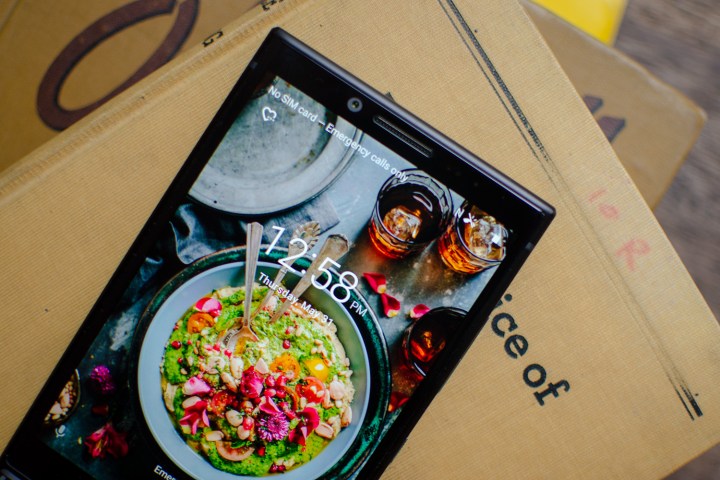
BlackBerry phones use Google’s Android as the operating system. BlackBerry 10 — and anything that came before it — is a thing of the past. On a modern BlackBerry phone, you get access to Google Play, all the usual Google apps, and a very similar user experience to that provided by a Samsung, LG, or any other Android phone.
Android 7.1 Nougat came installed on the KeyOne, and an
There are a variety of new software features on the Key2. These include new features in Locker, to which apps can now be added. Firefox Focus is also part of Locker now, enabling private browsing, and can be used to privately open links sent in emails or messages. BlackBerry’s DTEK has been given a visual update, making it cleaner-looking, and now has a system scanner that makes security recommendations. Some of these features will also come to the KeyOne in a future software update.
The software experience is similar between these two phones, but the Key2 will get updates for a longer period of time.
Winner: BlackBerry Key2
Keyboard

The physical keyboard was what made the KeyOne different, and it returns on the Key2, but with some crucial changes to make it not only more usable but also more newcomer friendly. This is very important. The KeyOne took practice to use with any speed and precision if you were coming directly from a touchscreen keyboard.
For the Key2, BlackBerry has introduced a new keyboard design that’s 20 percent larger than on the KeyOne, with the keys extending higher on the body than on its predecessor, and with new contours to make them more tactile. A matte finish replaces the sticker coating on the KeyOne’s keys, and the separators between each row have been reduced in height. There’s even a pleasing downward slope to each, now larger key, making it more comfortable and natural to press.
The difference is considerable. Even coming directly from the KeyOne, typists will immediately feel faster, and the entire typing process feels more coherent and natural. A lot of the extra space has been generated by losing the second shift key, but BlackBerry has also added a new key that activates user-definable shortcuts. Each letter key can be assigned two tasks, based on a short press or long press, and by using the new key at the same time, apps can be switched from within apps without using the app drawer.
It’s still a capacitive touch keyboard, enabling a quick scroll through web pages and the ability to select words from the predictive options when typing. The overall package of BlackBerry’s changes to the Key2’s keyboard is one that’s more comfortable to use, and less time-consuming and less frustrating to adapt to using. Whether you used the KeyOne or not, don’t base the Key2’s keyboard on previous experience with a modern Android BlackBerry phone, because they’re very different beasts.
Winner: BlackBerry Key2
Price and availability
The BlackBerry Key2 starts at $650, 650 euros, or 580 British pounds. The KeyOne was $550 at launch. BlackBerry says the price increase represents the investment in design, performance, and specifications, and pointed out that the upgraded Black Edition of the KeyOne cost $600, showing the increase is actually more minimal given the alterations.
The KeyOne is available now and it works on AT&T, T-Mobile, Verizon, and Sprint. The Key2 arrives on July 13, but it only works on AT&T and T-Mobile at the moment. Verizon and Sprint support may come later this summer.
Overall winner: BlackBerry Key2
The BlackBerry Key2 is the clear winner here. For only $100 over the KeyOne, you get a stronger processor, more RAM, a better camera, newer software, and best of all, a physical keyboard that’s easier to use even if you’re a hardened touchscreen typist. You can’t argue with that, and initial impressions show the Key2 to be a significant step forward for BlackBerry’s modern efforts.
Updated on June 21: Added U.S. availability of the Key2.
Editors' Recommendations
- BlackBerry trailer depicts the rise and fall of the iconic phone
- A new BlackBerry with a keyboard is still on the schedule for 2022
- Samsung Galaxy Watch Active 2 vs. Watch Active: Spec comparison
- BlackBerry rises from the grave: New 5G phone with a keyboard coming in 2021
- TCL won’t make BlackBerry phones anymore, sending the brand back into limbo




